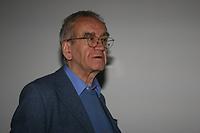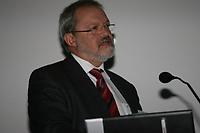Track 8: General, Part 2
#

Imrich Wilfried: Approximate Graph Products
#
This talk is concerned with approximate graph products and algorithms for their recognition.
The motivation for the introduction of approximate graph products comes from several, rather distinct fields.
In theoretical biology there are two contexts. The first pertains to sequence spaces. They help to study the evolution of genetic sequences and lead to Cartesian products of complete graphs. The second pertains to the relationship between genotypes and phenotypes. It can be modeled with strong products of graphs.
In both cases the graph products in question have to be estimated from biological data, and are thus only approximately known.
Similarly, approximate graph products arise in computational engineering and graph drawing.
With this background the talk continues with new algorithms for the recognition of graph products and shows how they can be adapted to the recognition of approximate graph products.
About Wilfried Imrich
He was born 1941 in Vienna, Austria, got his PhD in Mathematics at the University of Vienna 1965, was assistant professor at the Technical University of Vienna from 1965 until 1973, and intermittently assistant professor at the State University of New York at Albany from 1966 to 1969. He also spent research leaves at the Lomonosov University Moscow 1969/70 and American, Australian and Canadian Universities.
In Leoben he was Head of the Computer Center from 1985 until 1995 and Dean of Graduate Studies from 2001 until 2003. He is member of numerous editorial boards, (e.g. J. Algebraic Combinatorics, J. Universal Computer Science, Contr. to Discrete Mathematics) and member of the Beirat of the Austrian Mathematical Society.
Debreceny Roger: The Influence of IT Governance on IT Process Maturity
#
IT Governance has become of increasing importance in recent years as IT and business organizations struggle to balance competing needs for achieving organizational goals including agility, reliability and cost performance whilst meeting an increasing array of compliance requirements set by regulators. The Sarbanes-Oxley Act in the US and similar regulation in other countries brought home to a wide variety of private sector entities the need to strengthen IT governance and the maturity of key processes. While much of the research on IT Governance has considered particular aspects such as the organizational form of the IT function or the alignment of business and IT, the concept is broader. IT Governance is a managerial process designed to ensure that IT both meets organizational needs and manages the inherent risk that arises from IT-enabled business processes.
A number of management and control frameworks and standards exist that assist the Board, business and IT management in developing either the totality of IT Governance or particular subsets. Examples include ITIL, ISO 17799 and its successor standards and PMBOK. COBIT, published by the IT Governance Institute (ITGI), is a well understood and widely used IT management and control framework. COBIT is a tool for high-level governance over the complete IT lifecycle. It interoperates with the aforementioned IT-specific frameworks and standards as well as with Board-level corporate governance frameworks such as COSO and COCO.
A key aspect of IT Governance in general and COBIT in particular is building reliable and robust IT processes to support organizational goals. The COBIT framework adopts and adapts the Capability Maturity Model (CMM) from the software engineering research community. In this study, we report the results of a seven-country field study of more than fifty organizations in the private, public and not-for-profit sectors. We analyze current and predicted process maturity for more than 40 processes, from strategic planning to operations. We then assess the influence of key dimensions of IT governance on the level of process maturity. These dimensions include organizational form, formal and informal governance structures and compliance intensity.
About Roger Debreceny
His research interests are in IT governance, information systems auditing and assurance, Internet Financial Reporting, and the ontological structure of accounting information and business reporting systems. Debreceny holds the degrees of Master of Commerce, Master of Public Policy and PhD and is a Fellow CPA of CPA Australia. He has had extensive government and private sector experience and has taught at a number of universities in Australia and Singapore prior to taking up his current position. His doctoral thesis on the application of object technology to accounting information systems was awarded the Outstanding Dissertation Award by the Information Systems section of the American Accounting Association in 1999.
Debreceny serves as President-elect of the Artificial Intelligence/Emerging Technologies section of the American Accounting Association. He recently completed his term as Chair of the CobiT Steering Committee of the IT Governance Institute. Debreceny is the Associate Editor of the Journal of Information Systems and sits on a number of editorial boards including the European Accounting Review.
Trappl Robert: Programming for Peace?
#
Since the first computers were built they have been used to make "better warfare". Wars and conflicts appear to stay with us in the 21st century. Is it possible to use computers for improving "peacefare"? In this talk, results from the application of case-based reasoning and machine learning methods to war-, crisis- and conflict management dabases with the aim of giving directions for preventing or ending armed conflicts will be presented and potential consequences discussed.
About Robert Trappl
He is professor and head of the Institute of Medical Cybernetics and Artificial Intelligence, Center for Brain Research, Medical University of Vienna, Austria.
He holds a PhD in psychology (minor: astronomy), a diploma in sociology (Institute for Advanced Studies, Vienna), and is engineer for electrical engineering.
He has published more than 180 articles, is co-author, editor or co-editor of 34 books. He is author of the 2 hour video series "Introduction to Artificial Intelligence" (in German, Spektrum Videothek, Heidelberg). He has been on the editorial board of numerous scientific journals and has been a member of program committes of many national and international conferences.
His main research focus at present is the investigation of the potential contributions of Artificial Intelligence methods to the avoidance of outbreaks of wars or in ending them, and the development of intelligent and emotional personality agents both for synthetic actors in films, television and interactive media, especially games, and with a view on their consequeces for theories on cognition and emotion.
He has been giving lectures in many countries and he has been working as a consultant for national and international companies and organizations (OECD, UNIDO, WHO).
Landrock Peter: 30 years of PKI - from excitement through exhaustion to useful deployment
#
After much scrutiny by the scientific community, PKI really started taking off in the early to mid 90'es, only to create despair and disillusion in a number of deployments, not least because of the over-emphasis on the X.509 architecture, the legal aspects and the army of consultants with no practical experience responsible for the tenders. Legislation in Europe on digital signatures was premature and even pretended to rest on a more general principle than public key. Surviving solutions in Electronic Commerce and e-Government are still quite pedestrian and limited, although more advanced solutions start to emerge, e.g. in Austria, Luxemburg and some Scandinavian countries. But other grand-scale viable solutions emerged, too, and common to them all is that certificates and signatures are verified by devices and not humans, and this continues to be where the strength of PKI is tested and verified: In EMV for debit- and creditcards, in TPM (Trusted Platform Modules) and in e-Passports solutions, and we begin to appreciate the advantage of elliptic curves over e.g. RSA, as signature generation is much faster.
About Peter Landrock
Peter Landrock obtained his Ph.D. in mathematics in 1974 from the University of Chicago and started working with data security in 1984. He served as President of the International Association for Cryptologic Research from 1992 to 1995, and has been on the Board of Directors since then. At the University of Aarhus he has built one of the leading research teams in Data Security in Europe. He has been visiting professor at a number of universities, incl. IAS Princeton, Cambridge, and Leuven.
In 1997 Peter Landrock was asked to serve on the technical advisory board of the new Microsoft Research Lab at Cambridge University, UK. He also holds an honourable professorship at the University of Aarhus and has been a member of the Danish IT Security Council as an advisor to the Danish Government for the last seven years.
Continue to Glimpses in-between



